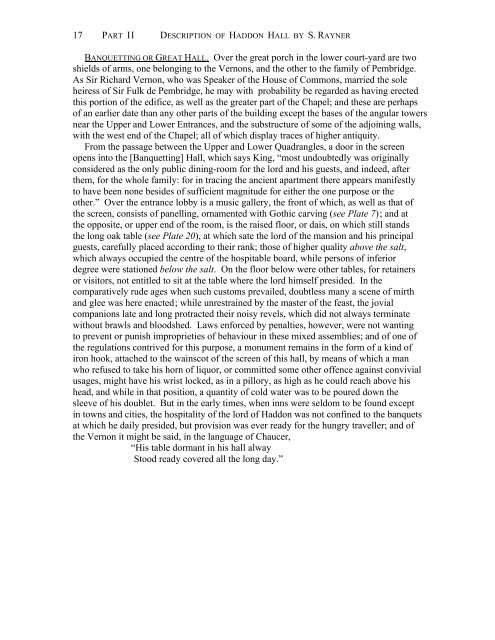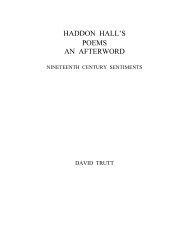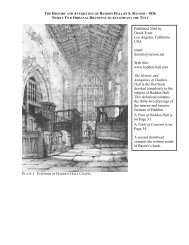Download - Haddon Hall
Download - Haddon Hall
Download - Haddon Hall
Create successful ePaper yourself
Turn your PDF publications into a flip-book with our unique Google optimized e-Paper software.
17 PART II DESCRIPTION OF HADDON HALL BY S. RAYNER<br />
BANQUETTING OR GREAT HALL. Over the great porch in the lower court-yard are two<br />
shields of arms, one belonging to the Vernons, and the other to the family of Pembridge.<br />
As Sir Richard Vernon, who was Speaker of the House of Commons, married the sole<br />
heiress of Sir Fulk de Pembridge, he may with probability be regarded as having erected<br />
this portion of the edifice, as well as the greater part of the Chapel; and these are perhaps<br />
of an earlier date than any other parts of the building except the bases of the angular towers<br />
near the Upper and Lower Entrances, and the substructure of some of the adjoining walls,<br />
with the west end of the Chapel; all of which display traces of higher antiquity.<br />
From the passage between the Upper and Lower Quadrangles, a door in the screen<br />
opens into the [Banquetting] <strong>Hall</strong>, which says King, “most undoubtedly was originally<br />
considered as the only public dining-room for the lord and his guests, and indeed, after<br />
them, for the whole family: for in tracing the ancient apartment there appears manifestly<br />
to have been none besides of sufficient magnitude for either the one purpose or the<br />
other.” Over the entrance lobby is a music gallery, the front of which, as well as that of<br />
the screen, consists of panelling, ornamented with Gothic carving (see Plate 7); and at<br />
the opposite, or upper end of the room, is the raised floor, or dais, on which still stands<br />
the long oak table (see Plate 20), at which sate the lord of the mansion and his principal<br />
guests, carefully placed according to their rank; those of higher quality above the salt,<br />
which always occupied the centre of the hospitable board, while persons of inferior<br />
degree were stationed below the salt. On the floor below were other tables, for retainers<br />
or visitors, not entitled to sit at the table where the lord himself presided. In the<br />
comparatively rude ages when such customs prevailed, doubtless many a scene of mirth<br />
and glee was here enacted; while unrestrained by the master of the feast, the jovial<br />
companions late and long protracted their noisy revels, which did not always terminate<br />
without brawls and bloodshed. Laws enforced by penalties, however, were not wanting<br />
to prevent or punish improprieties of behaviour in these mixed assemblies; and of one of<br />
the regulations contrived for this purpose, a monument remains in the form of a kind of<br />
iron hook, attached to the wainscot of the screen of this hall, by means of which a man<br />
who refused to take his horn of liquor, or committed some other offence against convivial<br />
usages, might have his wrist locked, as in a pillory, as high as he could reach above his<br />
head, and while in that position, a quantity of cold water was to be poured down the<br />
sleeve of his doublet. But in the early times, when inns were seldom to be found except<br />
in towns and cities, the hospitality of the lord of <strong>Haddon</strong> was not confined to the banquets<br />
at which he daily presided, but provision was ever ready for the hungry traveller; and of<br />
the Vernon it might be said, in the language of Chaucer,<br />
“His table dormant in his hall alway<br />
Stood ready covered all the long day.”







